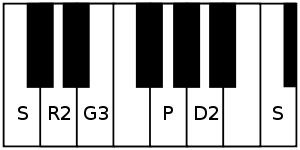Bilahari
| Arohanam | S R₂ G₃ P D₂ Ṡ |
|---|---|
| Avarohanam | Ṡ N₃ D₂ P M₁ G₃ R₂ S |
| Carnatic music |
|---|
Tanjavur-style Tambura |
| Concepts |
| Compositions |
| Instruments |
|
Bilahari is a rāgam in Carnatic music (musical scale of South Indian classical music). It is a janya rāgam (derived scale) from the 29th melakarta scale Sankarabharanam. It is a janya scale, as it does not have all the seven swaras (musical notes) in the ascending scale. It is a combination of the pentatonic scale Mohanam and the sampurna raga scale Sankarabharanam.[1] It is a morning rāgam.[1][2]
Structure and Lakshana


Bilahari is an asymmetric rāgam that does not contain madhyamam or nishādham in the ascending scale. It is an audava-sampurna rāgam (or owdava rāgam, meaning pentatonic ascending scale).[1][2] Its ārohaṇa-avarohaṇa structure (ascending and descending scale) is as follows:
- ārohaṇa : S R₂ G₃ P D₂ Ṡ[lower-alpha 1]
- avarohaṇa : Ṡ N₃ D₂ P M₁ G₃ R₂ S[lower-alpha 2]
The notes used in this scale are shadjam, chathusruthi rishabham, antara gandhara, panchamam and chathusruthi dhaivatham in ascending scale, with kakali nishadham and shuddha madhyamam included in descending scale. For the details of the notations and terms, see swaras in Carnatic music.
This rāgam also uses kaisiki nishadham (N2) as an external note (anya swara) in the descending scale. Hence it is considered a bhashanga rāgam, a scale with notes external to the parent scale.[1][2]
Popular Compositions
There are many compositions set to Bilahari rāgam. Here are some popular kritis composed in Bilahari.
- Na jeevadhara, Dorakuna ituvanti and Kanukontini composed by Tyagaraja
- Sri Balasubramanya by Muthuswami Dikshitar
- Smara Sada, Aaradhayami, Gopalam Seveham, Pahi Padmanabha, Jaya Suganalaya, Pahi Sarasanabha, Santhatham Bhajami and Vimukhava Tava by Maharaja Swathi Thirunal Rama Varma
- Parithana michite by Patnam Subramania Iyer
- Sri Chamundeshwari by Mysore Vasudevacharya
- Anaamilo mahaboob is a Khayal in Hindi by Maharaja Swathi Thirunal Rama Varma
- Puraya Mama Kamam is a Tharangam by Narayana Teertha
- "Raa ra venu gopala" a famous Swarajathi was composed in Bilahari
- Rabindranath Tagore has composed 'Ami Marer Sagor Pari Debo' In Raga Bilahari.
Related rāgams
This section covers the theoretical and scientific aspect of this rāgam.
Scale similarities
- Mohanam has a symmetric pentatonic scale, with the notes same as the ascending scale of Bilahari. Its ārohaṇa-avarohaṇa structure is S R2 G3 P D2 S : S D2 P G3 R2 S
- Mohanakalyani is a rāgam which has the prati madhyamam in descending scale (descending scale of Kalyani) in place of the shuddha madhyamam. Its ārohaṇa-avarohaṇa structure is S R2 G3 P D2 S : S N3 D2 P M2 G3 R2 S
- Garudadhvani is a rāgam which has the ascending and descending scales interchanged, in comparison with Bilahari. Its ārohaṇa-avarohaṇa structure is S R2 G3 M1 P D2 N3 S : S D2 P G3 R2 S
Desakshi is a raga which is similar to Bilahari. The arohana remains the same, while the sampoorna avarohana has Kaishiki Nishada in place of Kakali Nishada.